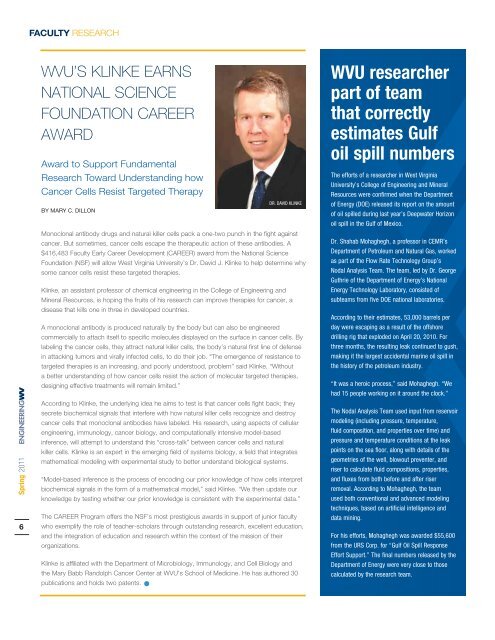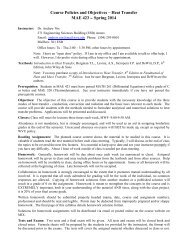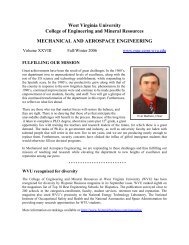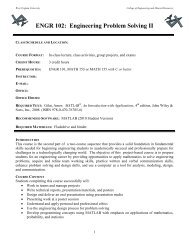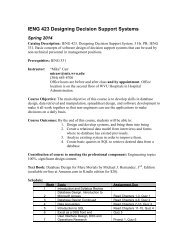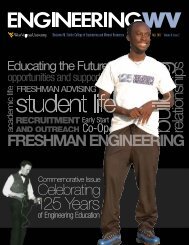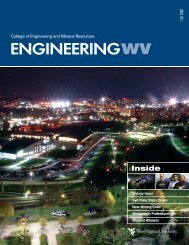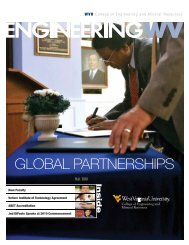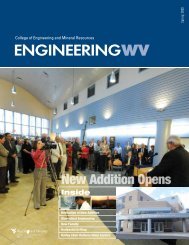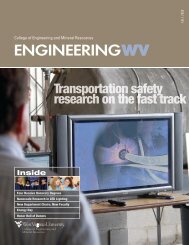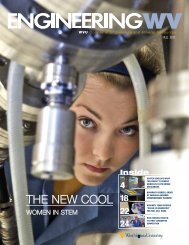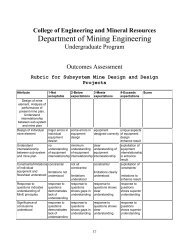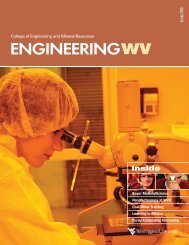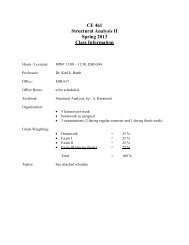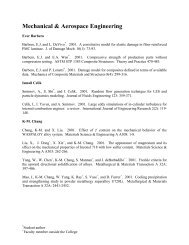2011 Spring - WVU College of Engineering and Mineral Resources ...
2011 Spring - WVU College of Engineering and Mineral Resources ...
2011 Spring - WVU College of Engineering and Mineral Resources ...
You also want an ePaper? Increase the reach of your titles
YUMPU automatically turns print PDFs into web optimized ePapers that Google loves.
Faculty ReseaRCh<strong>Spring</strong> <strong>2011</strong> ENGINEERINGWV6<strong>WVU</strong>’s Klinke earnsNational ScienceFoundation CAREERawardAward to Support FundamentalResearch Toward Underst<strong>and</strong>ing howCancer Cells Resist Targeted TherapyBy Mary C. DillonDr. David KlinkeMonoclonal antibody drugs <strong>and</strong> natural killer cells pack a one-two punch in the fight againstcancer. But sometimes, cancer cells escape the therapeutic action <strong>of</strong> these antibodies. A$416,483 Faculty Early Career Development (CAREER) award from the National ScienceFoundation (NSF) will allow West Virginia University’s Dr. David J. Klinke to help determine whysome cancer cells resist these targeted therapies.Klinke, an assistant pr<strong>of</strong>essor <strong>of</strong> chemical engineering in the <strong>College</strong> <strong>of</strong> <strong>Engineering</strong> <strong>and</strong><strong>Mineral</strong> <strong>Resources</strong>, is hoping the fruits <strong>of</strong> his research can improve therapies for cancer, adisease that kills one in three in developed countries.A monoclonal antibody is produced naturally by the body but can also be engineeredcommercially to attach itself to specific molecules displayed on the surface in cancer cells. Bylabeling the cancer cells, they attract natural killer cells, the body’s natural first line <strong>of</strong> defensein attacking tumors <strong>and</strong> virally infected cells, to do their job. “The emergence <strong>of</strong> resistance totargeted therapies is an increasing, <strong>and</strong> poorly understood, problem” said Klinke. “Withouta better underst<strong>and</strong>ing <strong>of</strong> how cancer cells resist the action <strong>of</strong> molecular targeted therapies,designing effective treatments will remain limited.”According to Klinke, the underlying idea he aims to test is that cancer cells fight back; theysecrete biochemical signals that interfere with how natural killer cells recognize <strong>and</strong> destroycancer cells that monoclonal antibodies have labeled. His research, using aspects <strong>of</strong> cellularengineering, immunology, cancer biology, <strong>and</strong> computationally intensive model-basedinference, will attempt to underst<strong>and</strong> this “cross-talk” between cancer cells <strong>and</strong> naturalkiller cells. Klinke is an expert in the emerging field <strong>of</strong> systems biology, a field that integratesmathematical modeling with experimental study to better underst<strong>and</strong> biological systems.“Model-based inference is the process <strong>of</strong> encoding our prior knowledge <strong>of</strong> how cells interpretbiochemical signals in the form <strong>of</strong> a mathematical model,” said Klinke. “We then update ourknowledge by testing whether our prior knowledge is consistent with the experimental data.”The CAREER Program <strong>of</strong>fers the NSF’s most prestigious awards in support <strong>of</strong> junior facultywho exemplify the role <strong>of</strong> teacher-scholars through outst<strong>and</strong>ing research, excellent education,<strong>and</strong> the integration <strong>of</strong> education <strong>and</strong> research within the context <strong>of</strong> the mission <strong>of</strong> theirorganizations.Klinke is affiliated with the Department <strong>of</strong> Microbiology, Immunology, <strong>and</strong> Cell Biology <strong>and</strong>the Mary Babb R<strong>and</strong>olph Cancer Center at <strong>WVU</strong>’s School <strong>of</strong> Medicine. He has authored 30publications <strong>and</strong> holds two patents.•<strong>WVU</strong> researcherpart <strong>of</strong> teamthat correctlyestimates Gulfoil spill numbersThe efforts <strong>of</strong> a researcher in West VirginiaUniversity’s <strong>College</strong> <strong>of</strong> <strong>Engineering</strong> <strong>and</strong> <strong>Mineral</strong><strong>Resources</strong> were confirmed when the Department<strong>of</strong> Energy (DOE) released its report on the amount<strong>of</strong> oil spilled during last year’s Deepwater Horizonoil spill in the Gulf <strong>of</strong> Mexico.Dr. Shahab Mohaghegh, a pr<strong>of</strong>essor in CEMR’sDepartment <strong>of</strong> Petroleum <strong>and</strong> Natural Gas, workedas part <strong>of</strong> the Flow Rate Technology Group’sNodal Analysis Team. The team, led by Dr. GeorgeGuthrie <strong>of</strong> the Department <strong>of</strong> Energy’s NationalEnergy Technology Laboratory, consisted <strong>of</strong>subteams from five DOE national laboratories.According to their estimates, 53,000 barrels perday were escaping as a result <strong>of</strong> the <strong>of</strong>fshoredrilling rig that exploded on April 20, 2010. Forthree months, the resulting leak continued to gush,making it the largest accidental marine oil spill inthe history <strong>of</strong> the petroleum industry.“It was a heroic process,” said Mohaghegh. “Wehad 15 people working on it around the clock.”The Nodal Analysis Team used input from reservoirmodeling (including pressure, temperature,fluid composition, <strong>and</strong> properties over time) <strong>and</strong>pressure <strong>and</strong> temperature conditions at the leakpoints on the sea floor, along with details <strong>of</strong> thegeometries <strong>of</strong> the well, blowout preventer, <strong>and</strong>riser to calculate fluid compositions, properties,<strong>and</strong> fluxes from both before <strong>and</strong> after riserremoval. According to Mohaghegh, the teamused both conventional <strong>and</strong> advanced modelingtechniques, based on artificial intelligence <strong>and</strong>data mining.For his efforts, Mohaghegh was awarded $55,600from the URS Corp. for “Gulf Oil Spill ResponseEffort Support.” The final numbers released by theDepartment <strong>of</strong> Energy were very close to thosecalculated by the research team.


